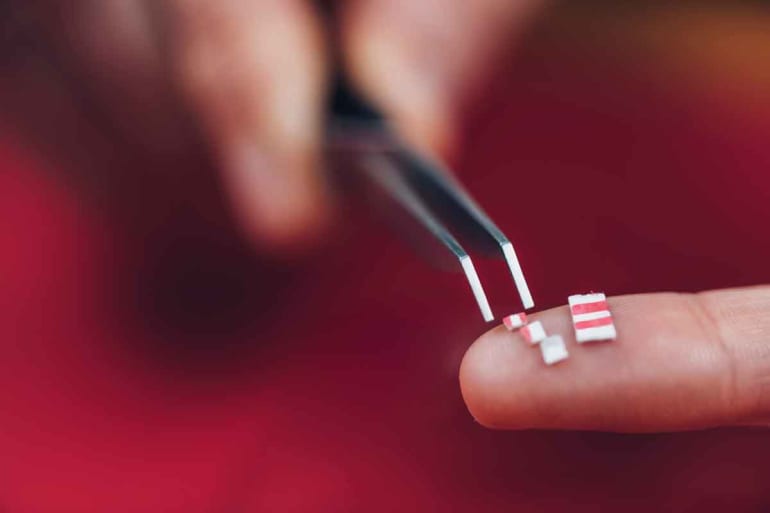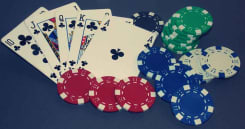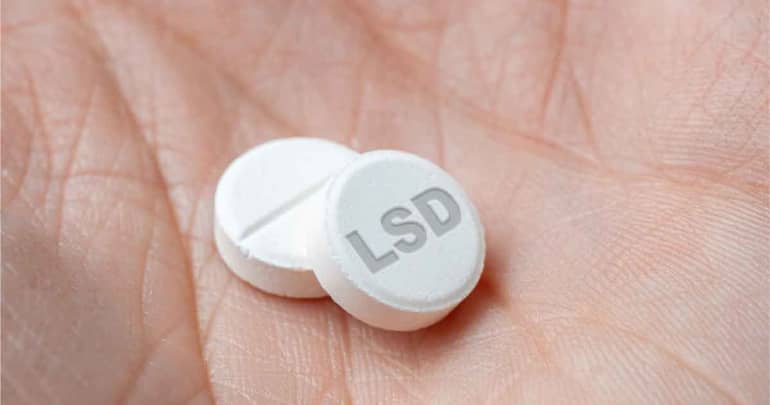LSD is notorious for its role in the counterculture of the 1960s and remains one of the most popular hallucinogens available today. It was first synthesized in the 1930s by a Swiss scientist named Albert Hofman and was a fixture during the Cold War.
It is a powerful mind-altering drug that causes the user to hallucinate, meaning they see, hear, or feel things that are not actually there. Recreational use of LSD is common in the music festival scene among people who enjoy the way it alters their perception of the experience.
Ingesting LSD causes intense and sometimes unpredictable experiences depending on numerous factors. The results of LSD use can be dangerous especially for those with no prior experience or those who struggle with mental illness.
Are you interested in learning more about LSD? Continue reading to find out everything you want to know about this powerful hallucinogen.
What is LSD?
LSD, short for D-lysergic acid diethylamide and also referred to as acid, is a strong, synthetic hallucinogenic or psychedelic drug. It is a mind-altering drug that causes extreme distortions to the way a user perceives the world around them.

Hallucinogen use isn’t as widespread as the use of other drugs, such as alcohol or prescription opioids. Still, an estimated 5.6 million people, or 2.0 percent of the population, used at least one hallucinogen in the past year.
They also aren’t addictive in the same way alcohol and opioids are but it is possible to develop a tolerance. Despite the differences between LSD and other drugs, it’s still a serious substance that can lead to dangerous outcomes at any dose.
LSD Definition
LSD is used as a recreational drug among people looking to alter their perception of life. Many people who use the drug describe the spiritual experience they have while under the influence, also called “tripping.” Acid causes a number of different physical, psychological, and sensory effects during these trips.
Acid trips consist of visual, auditory, and tactile hallucinations. This means the user sees, hears, or feels things that seem real to them but don’t exist in reality. These visuals include geometric patterns, vivid colors, and other illusions that vary in intensity depending on the dosage.
The drug also affects distorts the user’s perception of time while they are tripping. Some feel like time speeds up, slows down, or repeats itself. Users often experience a blend of these perceptions of time within a single trip.
There are some dangerous effects of LSD, especially for users with preexisting mental illness or other mental disorders. Someone who is inexperienced with hallucinogens or who takes an extremely high dose may experience heightened anxiety or panic attacks.
Other Names For LSD
Even though LSD is the most common name for the drug, people refer to it by a variety of other names. Another popular name for LSD is acid or blotter acid. Sometimes users refer to acid as “tabs” or “dots” because of the blotter paper tabs the drug is often dripped onto. One dose of acid is usually one small square tab or dot and is also called a “hit” of acid.

Heroin is one of the most dangerous and harmful drugs available. It causes an alarming amount of deaths due to overdose each year yet use continues rising. What exactly is heroin and why is it that people use it? Learn more about the drug, its effects, and how to find treatment for addiction.
More info
Cocaine is a drug notorious for its place in the clubbing and nightlife scenes of major cities throughout the world. What exactly is cocaine, how is it made, where does it come from, and what does it do? Learn more about the impact of cocaine on the body, on society, and more.
More infoLSD Chemical Structure
LSD is short for lysergic acid diethylamide, the molecular structure of the drug. Although it’s based on the isolated nucleus of a naturally-occurring fungus, LSD itself is not a drug that occurs naturally. Instead, it’s one particular derivative synthesized from the lysergic acid found in ergot.
How LSD Looks
The pure, synthesized form of lysergic acid diethylamide is a prismatic crystal. The water-soluble crystals are tasteless, colorless, and odorless. Pure LSD crystals are a highly concentrated chemical. One dose of the drug is between 50 and 500 micrograms which, in its crystalline form, is a grain roughly one-tenth the size of a grain of sand.
This is why you wouldn’t find LSD in its pure form on the street: the potency is much too high in quantities that are far too small. Instead, the crystals are diluted into a solution that allows for more manageable dosing.
Acid is most often found in the form of small squares, or “tabs,” torn from sheets of blotter paper. The blotter sheets are often decorated with cartoon characters or psychedelic patterns in bright colors. Each tab has one dose of acid dripped onto it. A user places the tab on or underneath their tongue where the acid can soak from the paper and enter their system.
You can also find acid in tablets, gelatin squares, or sugar cubes. Occasionally acid is found in its potent liquid form, the most concentrated and, therefore, the most dangerous form of the drug. These are less common than the typical blotter sheets, though, since blotter tabs are the easiest way to distribute acid.
Is LSD Legal?
LSD is not a legal drug in the United States. It is listed as a Schedule I substance under the Controlled Substances Act by the Drug Enforcement Administration. Schedule I drugs do not have any accepted use in the medical community and also have a high potential for abuse. LSD is categorized alongside other drugs such as heroin, ecstasy, peyote, and marijuana.
Despite the research stating there isn’t much risk for physical addiction to LSD, the hallucinogen remains a Schedule I drug. Although there is little risk of developing a traditional substance use disorder with LSD, though, that doesn’t mean it’s safe.
There is a risk that its powerful hallucinogenic properties will be too overwhelming to someone with a low tolerance for the experience. These “bad trips” have the chance to be the event that triggers a full-blown state of psychosis in an individual.
LSD Origins
Lysergic acid diethylamide was first synthesized on November 16, 1938, by a scientist named Albert Hoffman. Hoffman worked in the Sandoz pharmacological department in Basel, Switzerland. His team was studying derivatives of lysergic acid, the isolated nucleus of a fungus called ergot.

Hoffman synthesized the diethylamide derivative of lysergic acid, named LSD-25 at the time. Researchers noticed restlessness in the animals they ran tests on but observed no other useful medical properties. Lysergic acid diethylamide, LSD-25, was tabled and nothing more was written or observed about it.
Five years later, though, Hoffman couldn’t seem to forget about the restlessness observed as an effect of LSD-25. He synthesized the derivative once again on April 16, 1943. During the process, he accidentally ingested a small amount of this new synthesis of lysergic acid diethylamide. He soon noticed the strange effects of the drug.
On April 19, 1943, Hoffman decided to run another self-experiment with LSD-25. This time he ingested a larger dose of 0.25 milligrams and wrote about the experiment in his journal. Hoffman documented his psychedelic, hallucinatory experience of shifting perceptions, difficulties speaking, and visual distortions.
Today, Hoffman’s intentional dosing on April 19 is acknowledged as the world’s first intentional acid trip.

Methamphetamine is a strong illegal drug that causes a number of stimulating effects. It’s highly addictive with nearly a million active users each month. Plenty of misunderstanding surrounds the drug and its users, though. Learn more about methamphetamine and the impact it has on those who use it.
More info
Kratom is a mind-altering drug made from the leaves of a tree native to Southeast Asia. Learn about how the drug is made, how it's used, its effects, and more.
More infoWho Discovered LSD and When?
The origins of LSD are accidental rather than intentional. The scientist who discovered the chemical compound didn’t set out in search of a psychedelic experience. In fact, Albert Hoffman, the scientist who first synthesized LSD, almost missed the discovery entirely.
Hoffman’s willingness to follow through on his persistent curiosity is the reason LSD exists today. If it weren’t for a nagging inquisitiveness that took him back to his lysergic acid diethylamide synthesis more than five years later, LSD would have likely been shelved and forgotten forever.
The History of LSD
LSD has come a long way since Hoffman’s first intentional trip on April 19th, 1943. LSD is most often associated with the counterculture of the 1960s. Hippies and LSD seem to go hand-in hand but they weren’t the only ones using LSD. The drug has seen a variety of uses throughout the years following its discovery, some recreational and others controversial.
Project MK-Ultra
Project MK-Ultra was a program run by the Central Intelligence Agency (CIA) during the 1950s and 1960s. Sometimes referred to as the “mind control program,” Project MK-Ultra was a series of experiments that tested a variety of possible mind-control techniques. They tested numerous techniques including LSD, shock therapy, interrogation, hypnosis, and more.
The CIA thought LSD could be a useful psychological weapon during the Cold War. They tested the drug both on volunteers and unknowing participants to determine the variety of possible effects. Experiments involved not only government testing but tests run at universities, medical facilities, and pharmaceutical companies as well.
Ultimately, though, test results deemed LSD to be too unpredictable of a substance to use.Then in the 1970s the public learned of the Project MK-Ultra experiments. The scandal led to multiple lawsuits as well as a congressional investigation.
Leary and Alpert’s Harvard Experiments
LSD was popular during the late 1950s and early 1960s with academics at various universities. It hadn’t been criminalized at that time so use, although stigmatized, was still legal. Timothy Leary and Richard Alpert, two professors of psychology at Harvard University, conducted their own experiments with the drug.
Leary and Alpert gave Harvard graduate students doses of LSD and psilocybin mushrooms to learn more about their effects. Both were usually under the influence of the drug while they ran their experiments. The public became aware of the Harvard Psilocybin Projects, Leary and Alpert’s tests, which expanded concerns about LSD use.
Criminalization of LSD
As the 1960s progressed, the public attitude surrounding LSD turned increasingly cynical. The drug became synonymous with the counterculture and found itself lumped in with the negative opinions of it.
The LA Times published an article entitled “U.S. Plans Intensive Campaign Against LSD” in 1966. Science magazine published a piece in 1967 containing a claim that LSD damages chromosomes, furthering the negative view of the drug.
Public fear surrounding the drug grew quickly and the United States government banned the use of LSD officially in 1967. They categorized it as a Schedule I substance with the Drug Enforcement Administration where it remains today, along with substances including heroin, ecstasy, and marijuana.
The Use of LSD Today
Despite its inclusion as a controlled substance by the Drug Enforcement Administration, LSD is still in use today. It’s part of the family of hallucinogens containing drugs like psilocybin mushrooms and DMT.
Acid is a recreational drug that sees use among people seeking a heightened sense of consciousness or induced spiritual experience. It’s also a drug commonly used at music festivals, either on its own or in combination with substances such as ecstasy or molly.
LSD Use Statistics
LSD is far more of a niche drug than alcohol or marijuana and sees much less use in comparison. Still, according to the National Drug Intelligence Center, more than 20 million people in the U.S. ages 12 and older have tried LSD at least once in their life.
4.5 million of those individuals who have used LSD in their lifetime are between the ages of 18 and 25. Far more concerning, though, is the number of adolescents that have tried acid: approximately 742,000 young people between the ages of 12 and 17.
Monitoring the Future, a study from the University of Michigan, offers further insight. Almost 4 percent of high school seniors throughout the United States have used LSD at least once in the last year. More than 8 percent of that same group tried LSD at some point in their life.

Learn more about OxyContin, a powerful prescription opioid used to treat severe, long-term pain. It’s also a popular drug for recreational use and abuse. What is OxyContin? Uses, Side Effects, Contraindications, Dangers, and More.
More info
Benzodiazepines are a helpful medication for those who struggle with anxiety and sleep disorders. But they’re dangerous in the hands of recreational users.
More infoLSD Myths and Facts
There are plenty of myths surrounding the use of LSD, just like there are with any other drug. Some myths stem from the fear-mongering used to keep people from using drugs. Others come from simply misunderstanding the way the drug or its effects work. LSD myths can be dangerous, though, so it’s good to know what is a myth and what is a fact.

Some LSD Myths
There are many different LSD myths, some that grow from a kernel of truth while others are entirely outlandish. Regardless of their origin, though, LSD myths are just that: myths. Knowing what is true and what is false when it comes to using acid keeps people safe.
Friends can keep you from having a bad trip
Some people believe that taking acid with a group of friends can keep you from having a bad trip. This isn’t necessarily the case, even if there’s only one person in the group taking acid. LSD completely alters the way a person perceives the world. It isn’t always possible to reason with someone who is tripping. Your friends might not be able to help you stay in touch with reality nor keep you from having a bad trip.
Orange juice or Vitamin C can stop an acid trip
Some people believe that drinking orange juice or taking Vitamin C stops a bad acid trip. This is just another LSD myth. Neither orange juice nor Vitamin C can eliminate the effects of an acid trip. Once your body metabolizes the drug the effects are in place and you can’t keep them from happening. This is one of the reasons acid is such an intense drug: the effects are unpredictable and there is no way to stop them after they start.
Acid is necessary for a spiritual experience
Many people look to LSD as the ultimate way to unlock a connection with a spiritual realm. They believe taking acid is necessary to achieve a spiritual experience. Although the drug is known for its effects on perception, LSD is not necessary for a spiritual experience. You don’t have
to take a substance to make that desired connection. There are many different ways to connect with the world around you, both spiritually and otherwise, without taking drugs.
Once you take acid it never leaves your body
There is a common LSD myth that claims once you take acid it doesn’t fully metabolize and instead stays in your body indefinitely. Some believe that leftover LSD remains in your spinal fluid. Others take it further and insist that remaining acid can release at any time and send you into another trip. None of these statements are true, though. LSD is an unstable drug which means it metabolizes and passes through the body easily and quickly. It doesn’t leave behind a stockpile of residual psychedelics.
You’ll experience severe “acid flashbacks”
The idea of acid flashbacks piggybacks off the above LSD myth, that some of the drug stores up in the body and releases later on. In these terms, “acid flashbacks” do not exist. You won’t find yourself thrown into the depths of a psychedelic experience months or years after you take acid. Some people experience vivid recollections or sudden activation of memories of their acid trip that feel like a flashback. But the idea that you’ll experience severe acid-induced flashbacks months later is just a myth.
LSD Facts
Now that you know some LSD myths it’s also good to know some facts. Acid is a powerful drug that can lead to some serious side effects in people who aren’t able to handle the intensity of the shift in perception.
LSD blurs the lines between reality and your imagination
LSD does blur the line between reality and your imagination. It has hallucinatory properties that affect your senses and the way you observe the world around you. You might see, hear, smell, or feel things that feel completely real to you but are truly just part of your imagination.
The effects of LSD can last up to 12 hours
The effects of an acid trip can last as long as 12 hours in some cases. Although the drug itself metabolizes quickly its effects are long-lasting and difficult to come down from. You can’t truly talk or rationalize your way out of an acid trip. The only thing that diminishes the psychological effects of acid is time.
LSD use may trigger pre-existing mental illness
Another dangerous side effect of LSD is its ability to trigger pre-existing mental illnesses. It doesn’t necessarily cause conditions like depression, anxiety, schizophrenia, or bipolar disorder. If someone has the condition already, though, but hasn’t shown signs of it, an intense acid trip may trigger the effects of these conditions.
Addiction Treatment | Hawaii Island Recovery
How LSD Works
Now that you have more of an understanding of what LSD does you might be curious how it works. What is it about the drug that gives it its psychedelic properties? Why does it cause users to see, hear, and feel things that seem so real in their mind yet don’t exist in reality? How does acid affect the way a user perceives the passage of time?

Understanding of LSD
Despite the controlled nature of LSD, there is still some research available that helps explain how scientists think LSD works. A variety of studies conducted between the years 2004 and 2012 believe the drug alters a user’s perception by interacting with neural pathways that use serotonin, sometimes called the “happy chemical.”
Research shows that the prefrontal cortex shows some of the most neural activity while under the influence of LSD. This area of the brain plays a significant role in perception, cognition, and mood. It also reveals that numerous other regions of the brain responsible for the physiological response to panic and stress also show increased neural activity.
A smaller but more recent study from Yale University and the University of Zurich in Switzerland also looked at the actions of acid on the brain. The researchers noticed reduced connections between areas of the brain that regulate cognition. They also saw an increased connection between the areas responsible for sensory function.
The decrease in cognition and increase in sensory function likely affects the way acid’s hallucinatory effects take hold. Reality slips away as the hallucinations set in and alter an individual’s perception of what’s taking place around them.
LSD Trip Length
LSD typically does not have a quick onset time, nor do its effects dissipate quickly; acid trips last for hours at a time. Some users feel effects as soon as 20 minutes after ingesting the drug, but most feel the first effects of LSD starting around 60 to 90 minutes after ingestion.
The entire length of an LSD trip ranges between 6 to 15 hours, mostly depending on the amount taken. Most people take the drug expecting the most impactful effects of their acid trip to last about 12 hours on average.
There may be some residual effects from the drug that lasts up to six hours after the “comedown,” sometimes referred to as “afterglow” effects Even after the afterglow effects end, though, the body takes about a full day to return to its normal, natural state of being.
An acid trip causes an often life-altering reaction with the world around you. Your thoughts and senses are overloaded with both internal and external stimuli. Coming down from the trip itself is only the beginning. The ongoing psychological response, such as the time spent processing what happened during the trip, also needs to be considered.
Why is LSD Bad?
LSD might not seem like a bad drug right away because it isn’t addictive in the same way drugs like heroin or prescription amphetamines are. People don’t develop a compulsive need to use acid that overtakes every aspect of their lives. The majority of users try acid once or twice, or reserve their use for “special occasions.”
LSD is still a dangerous drug, though, whether it’s an addictive substance or not. The danger of acid differs from substances such as methamphetamine and prescription opioids. Problems with the drug arise because of the relatively unknown nature of what will happen after ingestion.
No one can truly predict how acid will affect a first-time user or even someone who has used it before. While the drug itself does not necessarily cause mental illness, it can result in the onset of a pre-existing mental illness.
Regardless of how prepared a person makes themselves, it’s impossible to know how an acid trip will play out. There are so many factors that can influence the direction of a trip and it can be difficult or impossible to “pull someone out” of a bad trip. They have to ride out the experience no matter how overwhelming or intense it may get.
Can LSD Kill You?
With such high national drug overdose rates it’s normal to wonder whether you can overdose or if LSD can kill you. The toxicity of LSD on its own isn’t enough to kill you and it’s difficult to overdose on LSD in the traditional sense of the word. Mixing it with other substances may amplify the toxicity of the drug, though, and put users at risk.
The greatest risk of acid use comes from the lowered inhibitions and overall unpredictable nature of a trip. People are more likely to get in an accident and hurt themselves while under the influence of LSD. There is also the risk that someone may have a bad trip and potentially hurt themselves as a result.

Learn more about gambling addiction, also called gambling disorder, which affects millions of Americans but is still somewhat misunderstood by many.
More infoLSD Effects on the Body
LSD doesn’t affect the body in the same way as alcohol, heroin, meth, or other drugs. For example, opioids cause users to feel extremely sleepy and “nod out.” Methamphetamine and cocaine give users incredible bursts of energy and excitement. Alcohol causes a relaxing,
unwinding sensation for many people after a drink or two.

Acid, and hallucinogens in general, don’t cause these same physical effects. While most substances have at least some physical response to the drug, LSD produces mostly sensory effects and bodily side effects.
Increased Energy
The one main effect LSD has on the body is increased energy. Some people who take acid notice an increase in energy levels while the drug starts to take effect. It isn’t as extreme as the energy levels of amphetamine drugs but it’s a noticeable burst of energy that comes with
the high.
LSD Effects On the Brain
There are many more LSD effects on the brain than there are on the body. Acid is known for its hallucinatory effects that cause users to see, feel, hear, and experience things that aren’t there. The high is referred to as “tripping” for the psychological trip people go on when they use the drug.

Current research indicates that the LSD effects on the brain are likely caused by their action on serotonin-transmitting neural pathways. There’s also a noticeable increase in prefrontal cortex activity when people use acid. The prefrontal cortex is responsible for mood, cognition, and overall perception.
LSD also affects certain areas of the brain that manage physical responses to stress and panic. Ultimately, the drug creates what’s essentially a drug-induced psychosis. Some people have a stimulating and enjoyable experience with acid but it’s ultimately an unpredictable drug. You won’t know how acid affects you personally until you try it.
LSD effects on the brain include some of the following things.
Hallucinations
LSD is most known for the hallucinations it causes. People describe seeing solid objects move, geometric patterns covering things, and other visual hallucinations. Others experience auditory and tactile hallucinations, meaning they hear or feel things that aren’t there.
Synesthesia
Synesthesia is a phenomenon where senses cross over and mingle with one another. For example, some individuals hear colors or taste sounds while high on acid. Synesthesia is a real-life phenomenon for some people but the effects are prominent for many people who are tripping.
Altered Sense of Self
People on acid experience an altered perception of themselves and their place in the world. The hallucinations caused by the drug make things throughout the world seem intricately intertwined. It makes people feel like a small part of the greater whole in the Universe.
Distorted Sense of Time
Acid has a significant impact on the way people perceive time while they’re under the influence of the drug. Sometimes it passes in quick spurts while other seconds and minutes feel long and drawn out and neverending.
Rapid Shifts in Emotion
Acid’s interactions with the prefrontal cortex result in rapid shifts in emotion. From excitement to wonder to anxiety to fear and back, people experience incredible ranges of emotion while on LSD. Sometimes individuals find themselves stuck in negative emotions, though, which has the potential to derail into a bad trip.
LSD Side Effects
LSD, like other drugs, comes with numerous physical side effects when using it. Some are mildly uncomfortable but most are unnoticeable. The side effects of LSD aren’t as severe as other drugs, though, and physical overdose isn’t necessarily a possibility.

Loss of Appetite
Loss of appetite is common while on LSD. Many people find they aren’t interested in eating during their trip.
Increased Heart Rate and Blood Pressure
Increased heart rate and blood pressure are common side effects of LSD use. They typically aren’t to the point of dangerous levels but can be noticeable if paying attention.
Higher Body Temperature
LSD use can cause a higher body temperature. Again, it’s usually not high enough to be a cause of concern but still, body temperature can rise while using acid.
Dizziness, Weakness, or Numbness
Dizziness, numbness, or weakness are common while high on acid. The drug causes extreme hallucinations that can be incredibly disorienting. These effects, along with the way LSD interacts with major areas of the brain, can cause these physical side effects.
Evidence-based Treatment | Hawaii Island Recovery
Discover the evidence-based treatment therapies
Holistic Therapies | Hawaii Island Recovery
Heal from addiction in your body, mind, and spirit.
LSD Long-Term Effects
One of the most common myths about LSD use is that some of the drug remains in your system and can activate months or years later. While this isn’t true, there are two possible LSD long-term effects. It doesn’t cause the same lasting physical effects that can happen when abusing other types of drugs. LSD’s long-term effects are psychological instead of physical.

Persistent Psychosis
Persistent Psychosis is one of the possible LSD long-term effects. Signs of persistent psychosis include:
- Scattered or distracting thoughts
- Visual disturbances
- Mood disturbances
- Paranoia
People are more likely to develop persistent psychosis if they have a history of mental illness. It more often develops in those who use LSD repeatedly but it can also develop after a single-use.
Antidepressant or antipsychotic drugs may be useful in treating people who have persistent psychosis. They can improve negative feelings and moods, as well as limit the symptoms of lasting psychoses.
Hallucinogen Persisting Perception Disorder (HPPD)
Hallucinogen Persisting Perception Disorder, or HPPD, is another type of the possible LSD long-term effects. HPPD occurs very rarely but the condition is intense for those who are diagnosed with it. Signs of HPPD include:
- Flashbacks
- Lasting visual, auditory, or tactile hallucinations
- Additional visual disturbances (light trails that follow moving objects or halos)
Additionally, sometimes the symptoms of HPPD are mistaken for other neurological disorders like a stroke or a brain tumor. Like persistent psychosis, it’s more likely to develop in people with pre-existing psychological troubles. HPPD has no set form of treatment but clinicians also use antidepressants and antipsychotics to relieve the effects of lasting disturbances.
LSD Overdose Symptoms
Some people may experience LSD overdose symptoms if they take too much of the drug. They experience overwhelming and usually terrifying hallucinations. LSD overdose is not like overdosing on most other drugs, though. Taking too much of the drug is not life-threatening like a heroin or benzodiazepine overdose. No one has died from taking too much LSD.

Some possible LSD overdose symptoms include the following signs.
Increased Blood Pressure
Using LSD can cause an increase in blood pressure.
Increased Heart Rate
Increased heart rate is a possible LSD overdose symptom.
Increased Respiratory Rate
Another possible symptom of LSD overdose is an increased respiratory rate
or fast breathing.
Sweating
LSD use causes a person to sweat more than normal, also called hyperhidrosis.
Impaired Cognition
Someone under the influence of LSD shows signs of impaired cognition. If they’re experiencing an overdose they may have difficulties thinking, focusing, or communicating.
Psychosis
Psychosis occurs when a person has trouble differentiating between what is real and what is not. LSD overdose symptoms may include psychosis if the trip or hallucinations are intense enough.
Panic
Panic is one of the clearest LSD overdose symptoms. A person having overwhelming hallucinations will likely feel nervous, fearful, or panicky.
Suicidal Ideation
Though a person cannot die from overdosing on LSD, they may be a danger to themselves or others because of their hallucinations. Suicidal ideation is a dangerous sign that someone has ingested too much LSD.
LSD Addiction
People do not usually use LSD in the same way people use other substances like alcohol, heroin, or cocaine. LSD addiction is possible but it’s not a physical addiction that people experience when using alcohol or other drugs. This doesn’t mean that it’s safe to use the drug in any way, though.

Some people enjoy the hallucinogenic properties of the drug. These individuals ingest it more often than is safe to do. Heavy LSD users develop a tolerance for the drug quickly and soon require larger doses to achieve the same effects. Once they stop using it for a few days or weeks, though, their built-up tolerance also diminishes quickly.
LSD Withdrawal Symptoms
LSD withdrawal symptoms differ from the withdrawal symptoms associated with other drugs. Aside from the quick development of a tolerance, there are no physical LSD withdrawal symptoms.
As the Therapeutic Advances in Psychopharmacology journal explains, “LSD use does not lead to physical dependence. However, tolerance, as mentioned, disappears after a few days of abstinence without producing craving. So, LSD dependence is typically psychological and not physical.”
Some of the psychological LSD withdrawal symptoms include:
- Nervousness or anxiety
- Restlessness
- General discomfort
- Depression
- Insomnia
- Hypersomnia
LSD Treatment
LSD treatment for someone who does not use other drugs usually doesn’t require a stay in medical detox. Medical detox helps people with severe physical withdrawal symptoms. Since LSD withdrawal symptoms are mainly psychological, detox will be of little use.
LSD treatment can include either inpatient rehab or an intensive outpatient program depending on each individual’s needs. If the threat of relapse is high, an inpatient program will be a more beneficial option. Someone who feels certain they’re ready to quit using will find an intensive outpatient program to be a sufficient form of treatment.
If you’re looking for treatment for LSD addiction, Hawaii Island Recovery can help. Our small, specialized facility is located on the beautiful big island of Hawaii. It’s the perfect environment to focus on your recovery and lay the foundation for a life free from substances.
Get Addiction Treatment
If you or a loved one need help, call Hawaii Island Recovery toll-free right now.
866-390-5070 Hawaii Island Recovery
Hawaii Island Recovery 










